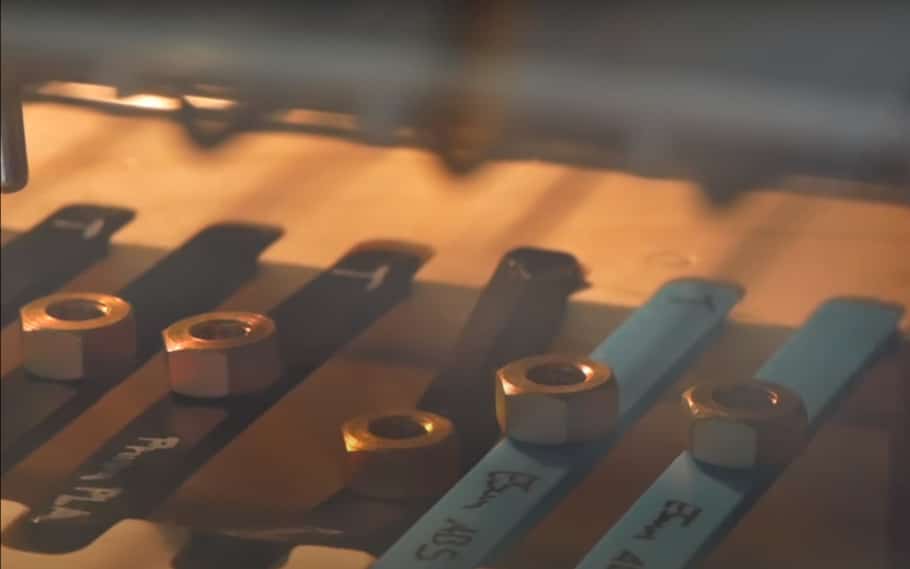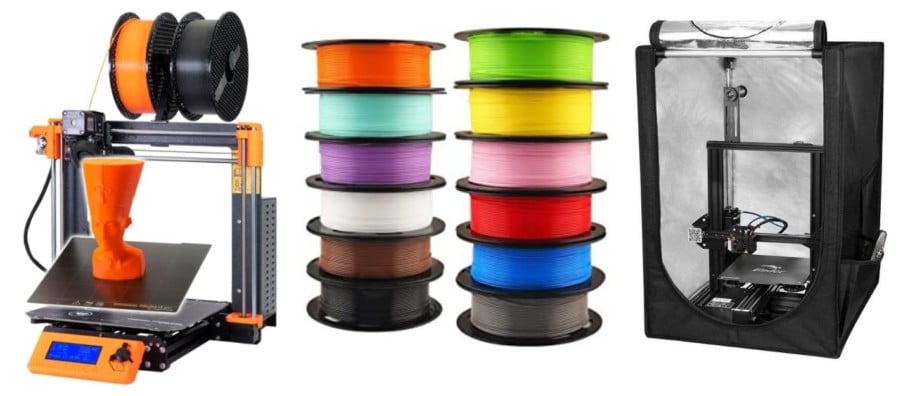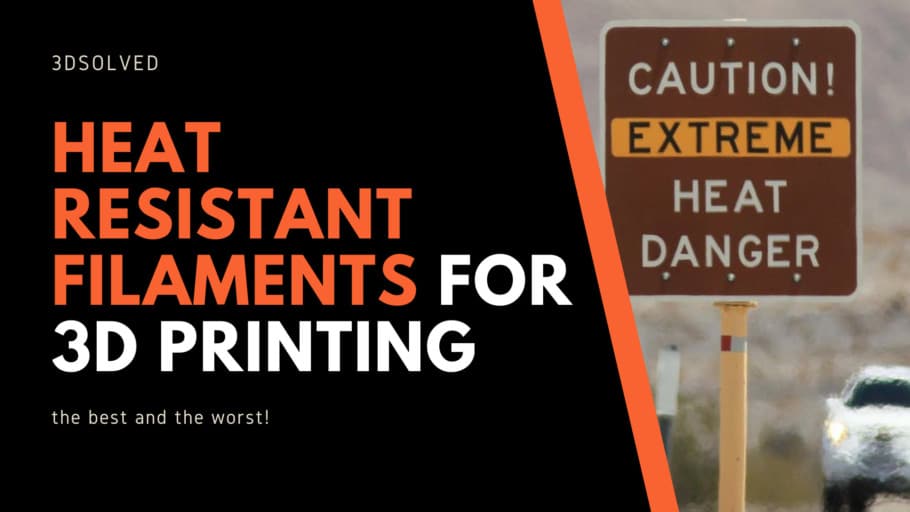3D printing parts are being used in an infinite array of industries and purposes. It is not uncommon that some uses require specific technical characteristics, such as impact strength, moisture resistance, UV resistance, or heat resistance. Today we will focus on heat resistance and determine which filaments best withstand heat.
When it comes to heat resistance, Polycarbonate is one of the best-suited thermoplastics since it’s glass transition temperature is 150°C. However, most printers can’t print with polycarbonate, which is why, at least for most people, the ideal filament is ABS since it’s got a glass transition temperature of 105°C.
| Material | Bed Temperature | Extrusion Temperature | Enclosure | Normal Printer | Glass Transition Temperature | Moisture Resistance | Price |
| PEEK | 120°C-145°C | 360°C-400°C | Yes | No | 143°C | High | $30-$40 |
| PAHT CF15 | 100°C-120°C | 260°C-280°C | Yes | Yes | 72°C | Low | $85-90 |
| Polycarbonate | 80°C-120°C | 260°C-310°C | Yes | Yes | 150°C | Low | $40-$60 |
| Polypropylene | 80°C-100°C | 230°C-260°C | Yes | Yes | -20°C (withstands 160°C) | High | $80-$110 |
| Polyamide | 70°C-80°C | 220°C-260°C | Yes | Yes | 60°C (withstands 120°C) | Low | |
| ABS | 90°C-110°C | 230°C-250°C | Yes | Yes | 105°C | Low | $15-$22 |
| PETG | 80°C-100°C | 210°C-250°C | No | Yes | 75°C | Low | $15-$25 |
Best heat resistant 3D Printing Filaments
The 3D industry is growing at a super-fast pace where new and better materials are being introduced on a regular basis. Heat resistance expands the scope of use of a specific filament, so we will take a look at a basic list of 3D filaments emphasizing their heat resistance and printing parameters from the most heat resistant to the least.
It should not be a surprise that regular PLA has a restriction order and has to stay at least 1 mile away from this list at any time.
PEEK
| Bed Temperature | 120°C-145°C |
| Extrusion Temperature | 360°C-400°C |
| Enclosure | Yes |
| Normal Printer | No |
| Glass Transition Temperature | 143°C |
| Moisture Resistance | High |
| Price | $30-$40 |
Polyether Ether Ketone (PEEK) is a semi-crystalline thermoplastic and is currently regarded as the best high performing polymer due to its thermal, mechanical and chemical qualities.
Not all printers are capable of printing with PEEK because of the high-temperature requirements. It has a glass transition temperature of 143°C and requires an operating temperature of 360-400°C with a bed temperature of 120-145°C. There are specialized printers designed to print with PEEK that includes an enclosed printing chamber. PEET prints can withstand temperatures of up to 260°C.
To give you a ballkpark figure of the maximum extrusion temperature that a regular 3d printer can achieve, the Prusa i3 has a maximum nozzle temperature of 300°C. This means that printing PEEK filament is out of the question.
In order to use this filament, you will have to get access to an industrial-grade 3d printer, for which you should expect to pay around 29.000usd (an estimated quote for the APIUM P220).
PEEK produces durable prints with high tensile strength, which are heat and water-resistant, and biocompatible, but working with the filament is complicated and demands that users are experienced and knowledgeable on what system will produce optimum results. PEEK is widely used in the medical, automotive, and aerospace industries, and parts like bearing, pumps, and compressor valves are printed to satisfaction.
PAHT CF15
| Bed Temperature | 100°C-120°C |
| Extrusion Temperature | 260°C-280°C |
| Enclosure | Yes |
| Normal Printer | Yes |
| Glass Transition Temperature | 72°C |
| Moisture Resistance | Low |
High-Temperature Polyamide carbon fiber reinforced (PAHT CF15) is an extremely strong and technically advanced material that contains 15% carbon fiber and is heat and chemical resistant.
PAHT CF15 prints can withstand constant temperatures of 150°C but can go up to 180°C for short periods of time. During printing, a bed temperature of 100-120°C is required with a nozzle temperature of 260-280°C. The glass transition temperature is 72°C, and a build chamber is required for optimum results.
These requirements allow us to print PAHT CF15 parts using a regular 3D printer, with the caveat that it requires a heated bed and an enclosure.
The filament is used in engineering applications for technical projects to fabricate moving parts and is oftentimes used as a replacement for metal components. This is due to the prints being heat resistant to acceptable levels as well as the stiffness and high tensile strength.
The filament is fairly easy to work with and poses no great printing challenges besides nozzle wear, so the appropriate nozzle should be selected.
Polycarbonate
| Bed Temperature | 80°C-120°C |
| Extrusion Temperature | 260°C-310°C |
| Enclosure | Yes |
| Normal Printer | Yes |
| Glass Transition Temperature | 150°C |
| Moisture Resistance | Low |
| Price | $40-$60 |
Polycarbonate (PC) is known for its strength and durability and remains the filament of choice for users who want a versatile filament that produces prints with high heat resistance, impact resistance, and optical clarity with the added bonus of being lightweight. Although prone to warping, the filament remains popular due to the end results.
An enclosed printing chamber is required to maintain print stability and quality. The nozzle temperature should be between 260°C and 310°C with a bed temperature of 80-120°C. The glass transition temperature of polycarbonate is 150°C, and prints can withstand heat up to about 140°C.
The first question that I try to answer when I research a new material is if I can print it with my normal 3D printer (not even a prosumer one). If you have a heated bed and an enclosed machine you can start printing with this industrial grade material with relative ease.
Polycarbonate filament is hygroscopic, meaning it absorbs moisture in the air, so proper storage is of the essence to keep it dry.
Moisture will cause print complications, and for this reason, every care should be taken to eliminate exposure to moisture by storing the filament in air-tight containers. During printing, the cooling fans should be switched off to allow for proper adhesion.
I’d recommend going with the Polymaker Polycarbonate.
Polypropylene
| Bed Temperature | 80°C-100°C |
| Extrusion Temperature | 230°C-260°C |
| Enclosure | Yes |
| Normal Printer | Yes |
| Glass Transition Temperature | -20°C (withstands 160°C) |
| Moisture Resistance | High |
| Price | $80-$110 |
Polypropylene is also a semi-crystalline thermoplastic with high chemical and impact resistant qualities making it excellent for use in the industrial sector, sportswear, and home appliance applications.
An extruder temperature of 230-260°C and a bed temperature of 80-100°C are required. The glass transition temperature is about 260°C. Because of the high heat requirements, a print chamber is necessary to control warping. The finished products can withstand temperatures between 82°C and 120°C, depending on the composition of the filament.
Polypropylene is not hygroscopic and works well with submerged components or items that are regularly in contact with moisture. It serves well as electrical insulation and is used extensively to create dishwasher and microwave sage kitchen utensils as well as medical equipment and parts. Polypropylene is known for the smooth finishes it constantly provides.
Polyamide (PA)
| Bed Temperature | 70°C-80°C |
| Extrusion Temperature | 220°C-260°C |
| Enclosure | Yes |
| Normal Printer | Yes |
| Glass Transition Temperature | 60°C (withstands 120°C) |
| Moisture Resistance | Low |
Polyamide has a semi-crystalline structure making it very strong as it is also flexible, adding to its strength. The final products are heat resistant and widely used in automotive, transportation, electrical, and electronic applications. PA is also abrasion, oil, and impact resistant.
PA can withstand temperatures up to 120°C for extended periods of time, and the printing temperature is between 220°C and 260°C. A bed temperature of 70-80°C is required while the glass temperature range between 55°C and 75°C. The cooling fan has to be turned off when printing with PA. You can download a Cura profile for printing with Polyamide here.
Most polyamide filaments are made with nylon, but some include glass fiber. PA is hygroscopic and must be dried before use. It is also prone to warping and requires an enclosed print chamber and no fan to control print deformation.
ABS (Acrylonitrile Butadiene Styrene)
| Bed Temperature | 90°C-110°C |
| Extrusion Temperature | 230°C-250°C |
| Enclosure | Yes |
| Normal Printer | Yes |
| Glass Transition Temperature | 105°C |
| Moisture Resistance | Low |
| Price | $15-$22 |
This thermoplastic requires no introduction, but here is one nonetheless. ABS is another popular 3D filament due to its high heat and damage resistance. Although it has great heat resistance, it is still prone to UV rays from the sun, and its counterpart ASA has UV protection, so it is suitable for outdoor use.
The printing temperature is about 240°C with a bed temperature of 90-100°C, while the glass transition temperature is 105°C. Finished prints can withstand temperatures close to 100°C but not for prolonged periods of time. Printing requires a print chamber as warping is fairly common with ABS.
ABS is hygroscopic, so care must be taken with storage in order to minimize contact with moisture. It can difficult to print due to warping on the outer corners of the print caused by uneven cooling. Although the filament is hygroscopic, prints tend to be water-resistant and are also impact-resistant, making them a great choice for most professionals.
If you’re thinking about buying ABS filament, don’t just buy any generic one but rather this brand of ABS since it works great and doesn’t break the bank.
Polyethylene terephthalate glycol-modified (PETG)
| Bed Temperature | 80°C-100°C |
| Extrusion Temperature | 210°C-250°C |
| Enclosure | No |
| Normal Printer | Yes |
| Glass Transition Temperature | 75°C |
| Moisture Resistance | Low |
| Price | $15-$25 |
PETG filament is very easy to print with and is comparable to PLA in this regard. However, PETG has better qualities relating to heat, water, and corrosive chemicals resistance.
PETG is able to withstand temperatures of up to 75°C. The nozzle extrusion temperature varies between 210-250°C and requires a heated bed at 80-100°C. The glass transition temperature is 75°C and a printing enclosure is not required as long as the ambient temperature is not too cold.
While printing, a fan is recommended only after the first layer has been established and is properly stuck to the bed. Thereafter, the cooling fan regulates the nozzle temperature and speeds up cooling to help prevent stringing and blobbing, giving your print a detailed finish.
PETG is used in the food and beverage industry as it can easily be sterilized and is fairly flexible yet robust. The sterilization properties make it ideal for use in the medical industry. In retail. PETG is used to manufacture stands for point-of-sale goods.
PETG is generally regarded as one of the best 3D printing filaments out there since it’s easy to print and can withstand high temperatures.
Is PLA Heat Resistant?

PLA is the least heat resistant of all the filament types, but it is by far the easiest to print due to its low heat requirements. Finished prints will not respond favorably to heated conditions like the inside of a locked car in the midday sun. PLA’s natural melting temperature is around 80°C but is improved with additives (oftentimes called PLA+). Like most filament types, PLA is also subjected to additives to improve overall application use.
Because PLA is biodegradable, it is commonly used in medical implants like tissue screws to aid healing. PLA comes in a variety of different grades that includes scientific, medical, food-safe, and finally comes to the standard PLA used in everyday 3D printing.
The recommended bed temperature for PLA is between 40°C and 60°C if you have decided to use a heated bed for better adhesive results. The nozzle temperature is set at about 190°C-215°C, depending on the brand and pigmentation.
PLA remains a functional and useful filament to print with, but due consideration should be given to the application of the print.
Is resin heat resistant?
Printing with resin involves an entirely different process where liquid resin is exposed to UV light which hardens and cures the exposed resin. Resin prints are basically made upside down, with the bottom of the resin tank controlling the UV light exposure.
Resin prints are pretty solid, but some do have a degree of flexibility that allows for multiple uses, including making crowns and bridge moulds in dentistry and engineering applications.
There are high-temperature resins that have low thermal expansion and high tensile strength that can produce fast accurate components. However, high-temperature resins produce a component with no flexibility, so clip-on, snap fits, and living hinges are not recommended.
The resin prints will have a heat deflection temperature of 289°C @ 0.45 MPa if you use High-Temp Resin. These materials do not melt, so glass transition temperature is not measured.
High-temperature resin prints are used as heat resistant fixtures, housing components, hot air and fluid control, mold prototyping and environmental testing. The functions and applications of high-temperature resins are ever growing as are the different resin types designed to meet the demands of cost-effective manufacturing excellence instilled throughout industries.
Check out our recommended products section

We created a recommended products section that will allow you to remove the guesswork and reduce the time spent researching what printer, filament, or upgrades to get, since we know that this can be a very daunting task and which generally leads to a lot of confusion.
We have selected just a handful of 3D printers that we consider to be good for beginners as well as intermediates, and even experts, making the decision easier, and the filaments, as well as the upgrades listed, were all tested by us and carefully selected, so you know that whichever one you choose will work as intended.
Error processing API data.
